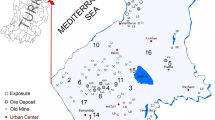Abstract
A great many Brazilian medicinal plants are used in wound healing. They are usually applied directly to wounds, somein natura as poultices, some as dried powders, and others as water extracts (teas) for bathing. Sixteen plants from the Atlantic Rain Forest of the State of Rio de Janeiro in Brazil were analyzed to determine the concentration of five minerals: silicon, manganese, iron, copper, and zinc to study their possible role in the healing processes. The analysis was performed in plant samples and in teas prepared from them. There appears to be a correlation between the healing effect of the plants and their content of these element.
Similar content being viewed by others
References
D. B. Milne, Trace elements, Appendix—Table 41–20 Clinical chemistry and toxicology, inTietz Textbook of Clinical Chemistry, 2nd ed., C. A. Burtis and E. R. Ashwood, eds., W. B. Saunders, Philadelphia, pp. 1317–1353, 2176–2211 (1984).
M. N. Huges, Metalo- and metal-activated enzymes in hydrolysis and group transfer reactions, a postscript on non-metals as trace elements, inThe Inorganic Chemistry of Biological Processes, 2nd ed., Wiley, New York, pp. 89–125, 319–324 (1981).
M. R. Werbach, Wound healing, inNutritional Influences on Illness—A Sourcebook of Clinical Research, 2nd ed., Third Line Press, Tarzana, CA, pp. 615–620 (1993).
J. J. R. Frausto da Silva and R. J. P. Williams, Zn: Lewis acid catalysis and regulation. Non-haem iron: Redox reactions and controls. Mn: Dioxigen evolution and glycosylation. Cu: Extracytoplasmic oxidases and matrix formation. Mans’ use of the chemical elements in biological environments, inThe Biological Chemistry of the Elements. The Inorganic Chemistry of Life, Clarendon, Oxford, pp. 299–318, 319–342, 370–387, 388–399, 531–552 (1991).
H. A. Harper, V. W. Rodwell, and P. A. Mayes, O ciclo do ácido citrico e o catabolismo da acetil-CoA. Metabolismo da água e dos minerais, inManual de Química Fisiológica, Atheneu Editora SÃo Paulo Ltda, SÃo Paulo, pp. 299–307, 595–624 (1982).
R. S. Cotran, V. Kumar, and S. L. Robbins, Healing and repair. Nutritional disease, inRobbins Pathological Basis of Disease, 4th ed., W. B. Saunders, Philadelphia, pp. 71–84, 461–462 (1989).
C. A. Burtis and E. R. Ashwood, Histology of the skin, inLever Gundula Schaumburg Histopathology of the Skin, 6th ed., W. F. Lever, ed., Lippincott, Philadelphia, pp. 29–32 (1983).
A. Balbach,A Flora Nacional na Medicina Doméstica, 22nd ed., EdiÇÕes “A EdificaÇÃo do Lar,” Itaquaquecetuba, SÃo Paulo (1975).
P. Gupta Mahabir, ed., 270 plantas medicinales Iberoamericanas. Programa Iberoamericano de Ciencia y Tecnologia para el Desarollo. Subprograma de Quimica Fina Farmaceutica, Convenio Andres Bello, Santafé de Bogotá, DC-Colombia (1995).
National Bureau of Standards, Certificate of Analysis, Standard Reference Material No. 1572, Citrus Leaves (1982).
Silicon, inStandard Methods for Examination of Water and Waste Water, 8th ed., A. E. Greenberg, ed., American Public Health Association, American Water Works Association and Water Environment Federation, Washington, DC, pp 117–122 (1992).
T. J. Keenan. Outliers, inQuality Assurance of Chemical Measurements, Lewis Publishers, Boca Raton, FL, pp. 33–39 (1987).
M. Negreiros Vaz and C. T. A. Candida,Silício em Sistemas Biológicos, Instituto Superior Técnico, Lisboa, Portugal (1982).
Author information
Authors and Affiliations
Rights and permissions
About this article
Cite this article
Pereira, C.E.d.B., Felcman, J. Correlation between five minerals and the healing effect of Brazilian medicinal plants. Biol Trace Elem Res 65, 251–259 (1998). https://doi.org/10.1007/BF02789100
Received:
Revised:
Accepted:
Issue Date:
DOI: https://doi.org/10.1007/BF02789100




